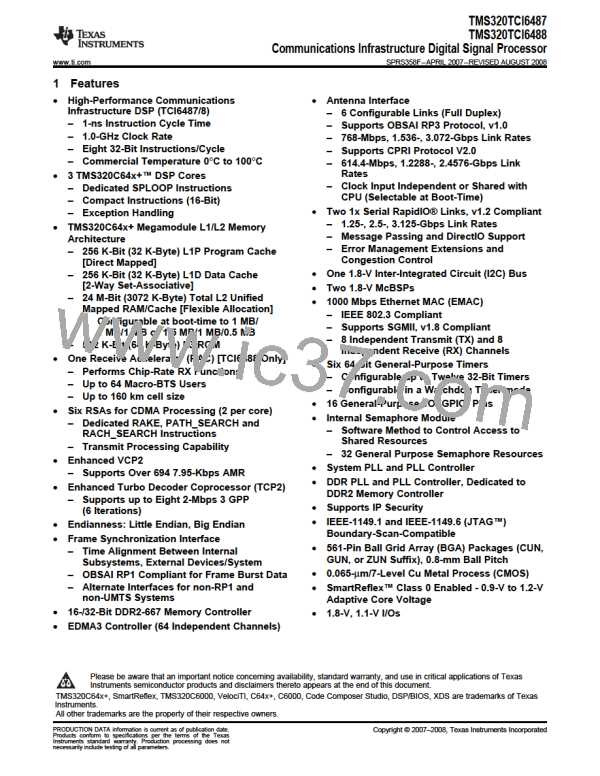TMS320TCI6487
TMS320TCI6488
Communications Infrastructure Digital Signal Processor
www.ti.com
SPRS358F–APRIL 2007–REVISED AUGUST 2008
Table 2-1. Characteristics of the TCI6487/8 Processor (continued)
HARDWARE FEATURES
TCI6487/8
Product Status(1)
Product Preview (PP), Advance Information (AI), or
Production Data (PD)
PD
Device Part Numbers
(For more details on C64x+ DSP part numbering, see
Figure 2-11)
TMS320TCI6487CUN/GUN/ZUN
TMS320TCI6488CUN/GUN/ZUN
(1) PRODUCTION DATA information is current as of publication date. Products conform to specifications per the terms of Texas
Instruments standard warranty. Production processing does not necessarily include testing of all parameters.
2.2 CPU (DSP Core) Description
The C64x+ central processing unit (CPU) consists of eight functional units, two register files, and two data
paths as shown in Figure 2-1. The two general-purpose register files (A and B) each contain 32 (thirty-two)
32-bit registers for a total of 64 registers. The general-purpose registers can be used for data or can be
data address pointers. The data types supported include packed 8-bit data, 32-bit data, 40-bit data, and
64-bit data. Values larger than 32 bits, such as 40-bit-long or 64-bit-long values are stored in register
pairs, with the 32 LSBs of data placed in an even register and the remaining 8 or 32 MSBs in the next
upper register (which is always an odd-numbered register).
The eight functional units (.M1, .L1, .D1, .S1, .M2, .L2, .D2, and .S2) are each capable of executing one
instruction every clock cycle. The .M functional units perform all multiply operations. The .S and .L units
perform a general set of arithmetic, logical, and branch functions. The .D units primarily load data from
memory to the register file and store results from the register file into memory.
The C64x+ CPU extends the performance of the C64x core through enhancements and new features.
Each C64x+ .M unit can perform one of the following each clock cycle: one 32 x 32 bit multiply, two 16 x
16 bit multiplies, two 16 x 32 bit multiplies, four 8 x 8 bit multiplies, four 8 x 8 multiplies with add
operations and four 16 x 16 multiplies with add/subtract capabilities (including a complex multiply). There
is also support for Galois filed multiplication for 8-bit and 32-bit data. Many communications algorithms
such FFTs and modems require complex multiplication. The complex multiply (CMPY) instruction takes
four 16-bit inputs and produces a 32-bit real and a 32-bit imaginary output. There are also complex
multiplies with rounding capability that produces one 32-bit packed output that contain 16-bit real and
16-bit imaginary values. The 32 x 32 bit multiply instructions provide the extended precision necessary for
audio and other high-precision algorithms on a variety of signed and unsigned 32-bit data types.
The .L or arithmetic logic unit now incorporates the ability to do parallel add/subtract operations on a pair
of common inputs. Versions of this instruction exist to work on 32-bit data or on pairs of 16-bit data
performing dual 16-bit add and subtracts in parallel. There are also saturated forms of these instructions.
The C64x+ core enhances the .S unit in several ways. In the C64x core, dual 16-bit MIN2 and MAX2
comparisons were only available on the .L units. On the C64X+ core, they are also available on the .S unit
which increases the performance of algorithms that do searching and sorting. Finally, to increase data
packing and unpacking throughput, the .S unit allows sustained high performance for the quad 8-bit/16-bit
and dual 16-bit instructions. Unpack instructions prepare 8-bit data for parallel 16-bit operations. Pack
instructions return parallel results to output precision including saturation support.
Other new features include:
•
SPLOOP - a small instruction buffer in the CPU that aids in creation of software pipelining loops where
multiple iterations of a loop are executed in parallel. The SPLOOP buffer reduces the code size
associated with software pipelining. Furthermore, loops in the SPLOOP buffer are fully interruptible.
•
Compact Instructions - The native instruction size of the C6000 devices is 32 bits. Many common
instructions such as MPY, AND, OR, ADD, and SUB can be expressed as 16 bits if the C64x+
compiler can restrict the code to use certain registers in the register file. This compression is
performed by the code generation tools.
Submit Documentation Feedback
Device Overview
9

 TI [ TEXAS INSTRUMENTS ]
TI [ TEXAS INSTRUMENTS ]